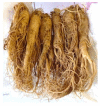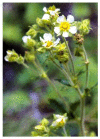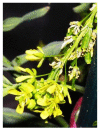Aromatic Herbs, Medicinal Plant-Derived Essential Oils, and Phytochemical Extracts as Potential Therapies for Coronaviruses: Future Perspectives
- PMID: 32604842
- PMCID: PMC7356962
- DOI: 10.3390/plants9060800
Aromatic Herbs, Medicinal Plant-Derived Essential Oils, and Phytochemical Extracts as Potential Therapies for Coronaviruses: Future Perspectives
Abstract
After its recent discovery in patients with serious pneumonia in Wuhan (China), the 2019 novel coronavirus (2019-nCoV), named also Severe Acute Respiratory Syndrome Coronavirus 2 (SARS-CoV-2), has spread quickly. Unfortunately, no drug or vaccine for treating human this coronavirus infection is available yet. Numerous options for controlling or preventing emerging 2019-nCoV infections may be predicted, including vaccines, interferon therapies, and small-molecule drugs. However, new interventions are likely to require months to years to develop. In addition, most of the existing antiviral treatments frequently lead to the development of viral resistance combined with the problem of side effects, viral re-emergence, and viral dormancy. The pharmaceutical industry is progressively targeting phytochemical extracts, medicinal plants, and aromatic herbs with the aim of identifying lead compounds, focusing principally on appropriate alternative antiviral drugs. Spices, herbal medicines, essential oils (EOs), and distilled natural products provide a rich source of compounds for the discovery and production of novel antiviral drugs. The determination of the antiviral mechanisms of these natural products has revealed how they interfere with the viral life cycle, i.e., during viral entry, replication, assembly, or discharge, as well as virus-specific host targets. Presently, there are no appropriate or approved drugs against CoVs, but some potential natural treatments and cures have been proposed. Given the perseverance of the 2019-nCoV outbreak, this review paper will illustrate several of the potent antiviral chemical constituents extracted from medicinal and aromatic plants, natural products, and herbal medicines with recognized in vitro and in vivo effects, along with their structure-effect relationships. As this review shows, numerous potentially valuable aromatic herbs and phytochemicals are awaiting assessment and exploitation for therapeutic use against genetically and functionally different virus families, including coronaviruses.
Keywords: 2019-nCoV; COVID-19; MERS-CoV; SARS-CoV; Severe Acute Respiratory Syndrome Coronavirus 2; antiviral activity; essential oils; herbal medicines; medicinal plants; phytochemicals.
Conflict of interest statement
The authors declare no conflict of interest.
Figures




















Similar articles
-
The role of natural products from medicinal plants against COVID-19: traditional medicine practice in Tanzania.Heliyon. 2022 Jun 15;8(6):e09739. doi: 10.1016/j.heliyon.2022.e09739. eCollection 2022 Jun. Heliyon. 2022. PMID: 35747321 Free PMC article.
-
Effect of the Phytochemical Agents against the SARS-CoV and Some of them Selected for Application to COVID-19: A Mini-Review.Curr Pharm Biotechnol. 2021;22(4):444-450. doi: 10.2174/1389201021666200703201458. Curr Pharm Biotechnol. 2021. PMID: 32619167 Review.
-
Current Strategies of Antiviral Drug Discovery for COVID-19.Front Mol Biosci. 2021 May 13;8:671263. doi: 10.3389/fmolb.2021.671263. eCollection 2021. Front Mol Biosci. 2021. PMID: 34055887 Free PMC article. Review.
-
Current status of antivirals and druggable targets of SARS CoV-2 and other human pathogenic coronaviruses.Drug Resist Updat. 2020 Dec;53:100721. doi: 10.1016/j.drup.2020.100721. Epub 2020 Aug 26. Drug Resist Updat. 2020. PMID: 33132205 Free PMC article. Review.
-
Natural compounds may contribute in preventing SARS-CoV-2 infection: a narrative review.Food Sci Hum Wellness. 2022 Sep;11(5):1134-1142. doi: 10.1016/j.fshw.2022.04.005. Epub 2022 Jun 2. Food Sci Hum Wellness. 2022. PMID: 38621001 Free PMC article. Review.
Cited by
-
A review of natural products, their effects on SARS-CoV-2 and their utility as lead compounds in the discovery of drugs for the treatment of COVID-19.Med Chem Res. 2022;31(1):40-51. doi: 10.1007/s00044-021-02826-2. Epub 2021 Dec 2. Med Chem Res. 2022. PMID: 34873386 Free PMC article. Review.
-
Anti-HIV reverse transcriptase plant polyphenolic natural products with in silico inhibitory properties on seven non-structural proteins vital in SARS-CoV-2 pathogenesis.J Genet Eng Biotechnol. 2021 Jul 16;19(1):104. doi: 10.1186/s43141-021-00206-2. J Genet Eng Biotechnol. 2021. PMID: 34272647 Free PMC article.
-
Comparative Analysis of Five Moroccan Thyme Species: Insights into Chemical Composition, Antioxidant Potential, Anti-Enzymatic Properties, and Insecticidal Effects.Plants (Basel). 2025 Jan 3;14(1):116. doi: 10.3390/plants14010116. Plants (Basel). 2025. PMID: 39795376 Free PMC article.
-
Identifying plant-derived antiviral alkaloids as dual inhibitors of SARS-CoV-2 main protease and spike glycoprotein through computational screening.Front Pharmacol. 2024 Jul 17;15:1369659. doi: 10.3389/fphar.2024.1369659. eCollection 2024. Front Pharmacol. 2024. PMID: 39086396 Free PMC article.
-
Effect of Licorice Essential Oil (Glycyrrhizaglabraglabra) on Performance and Some Biochemical Parameters of Broiler Chickens.Arch Razi Inst. 2023 Feb 28;78(1):95-105. doi: 10.22092/ARI.2022.359522.2442. eCollection 2023 Feb. Arch Razi Inst. 2023. PMID: 37312740 Free PMC article.
References
Publication types
LinkOut - more resources
Full Text Sources
Other Literature Sources
Research Materials
Miscellaneous

